
A | B | C | D | E | F | G | H | CH | I | J | K | L | M | N | O | P | Q | R | S | T | U | V | W | X | Y | Z | 0 | 1 | 2 | 3 | 4 | 5 | 6 | 7 | 8 | 9
Okinawa Prefecture
沖縄県 | |
|---|---|
| Japanese transcription(s) | |
| • Japanese | 沖縄県 |
| • Rōmaji | Okinawa-ken |
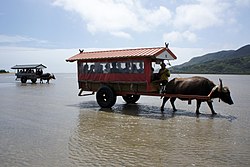 Tourists on traditional buffalo carts arrive at Yubu Island in Taketomi Town, Yaeyama District, Okinawa Prefecture. | |
| Anthem: 沖縄県民の歌 (Okinawa kenmin no uta) | |
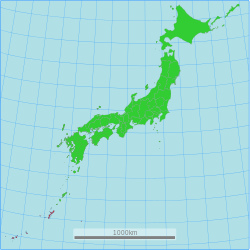 | |
| Coordinates: 26°30′N 128°0′E / 26.500°N 128.000°E | |
| Country | |
| Region | Kyushu |
| Island | Okinawa, Daitō, Miyako, Yaeyama, and Senkaku |
| Capital | Naha |
| Subdivisions | Districts: 5, Municipalities: 41 |
| Government | |
| • Governor | Denny Tamaki |
| Area | |
| • Total | 2,281 km2 (881 sq mi) |
| • Rank | 44th |
| Population (May 1, 2020) | |
| • Total | 1,466,870 |
| • Rank | 29th |
| • Density | 640/km2 (1,700/sq mi) |
| GDP | |
| • Total | JP¥ 4,633 billion US$ 42.5 billion (2019) |
| ISO 3166 code | JP-47 |
| Website | www |
| Symbols of Japan | |
| Bird | Okinawa woodpecker (Sapheopipo noguchii) |
| Fish | Banana fish (Pterocaesio diagramma, "takasago", "gurukun") |
| Flower | Deego (Erythrina variegata) |
| Tree | Pinus luchuensis ("ryūkyūmatsu") |
Okinawa Prefecture (Japanese: 沖縄県, Hepburn: Okinawa-ken) is the southernmost and westernmost prefecture of Japan.[2] It has a population of 1,457,162 (as of 2 February 2020[update]) and a geographic area of 2,281 km2 (880 sq mi).
Naha is the capital and largest city, with other major cities including Okinawa, Uruma, and Urasoe.[3] Okinawa Prefecture encompasses two thirds of the Ryukyu Islands, including the Okinawa, Daitō and Sakishima groups, extending 1,000 kilometres (620 mi) southwest from the Satsunan Islands of Kagoshima Prefecture to Taiwan (Hualien and Yilan Counties). Okinawa Prefecture's largest island, Okinawa Island, is the home to a majority of Okinawa's population. Okinawa's indigenous ethnic group is the Ryukyuan people, who also live in the Amami Islands of Kagoshima Prefecture.
Okinawa was ruled by the Ryukyu Kingdom from 1429 and unofficially annexed by Japan after the Invasion of Ryukyu in 1609. Okinawa was officially founded in 1879 by the Empire of Japan after seven years as the Ryukyu Domain, the last domain of the Han system. Okinawa was occupied by the United States during the Allied occupation of Japan after World War II and was governed by the Military Government of the Ryukyu Islands from 1945 to 1950 and Civil Administration of the Ryukyu Islands from 1950 until the prefecture was returned to Japan in 1972. Okinawa comprises just 0.6 percent of Japan's total land mass, but about 26,000 (75%) of United States Forces Japan personnel are assigned to the prefecture; the continued U.S. military presence in Okinawa is controversial.[4][5]
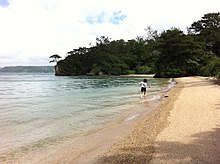
History
| History of Ryukyu |
|---|
 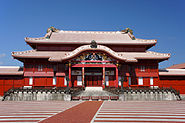 |

The oldest evidence of human existence on the Ryukyu Islands is from the Stone Age and was discovered in Naha[6] and Yaeyama.[7]: 86 Some human bone fragments thought to be from the Paleolithic era were unearthed from a site in Naha, but the artifact was lost in transportation before it was examined.[6] Japanese Jōmon influences are dominant on the Okinawa Islands, although clay vessels on the Sakishima Islands have a commonality with those in Taiwan.[note 1]
The first mention of the word Ryukyu was written in the Book of Sui.[note 2] Okinawa was the Japanese word identifying the islands, first seen in the biography of Jianzhen, written in 779.[note 3] Agricultural societies begun in the 8th century slowly developed until the 12th century.[note 4][14][15] Since the islands are located at the eastern perimeter of the East China Sea relatively close to Japan, China and Southeast Asia, the Ryukyu Kingdom became a prosperous trading nation. Also during this period, many Gusukus, similar to castles, were constructed. The Ryukyu Kingdom entered into the Imperial Chinese tributary system under the Ming dynasty beginning in the 15th century, which established economic relations between the two nations.
In 1609, the Shimazu clan, which controlled the region that is now Kagoshima Prefecture, invaded the Ryukyu Kingdom. The Ryukyu Kingdom was obliged to agree to form a suzerain-vassal relationship with the Satsuma and the Tokugawa shogunate, while maintaining its previous role within the Chinese tributary system; Ryukyuan sovereignty was maintained since complete annexation would have created a conflict with China. The Satsuma clan earned considerable profits from trade with China during a period in which foreign trade was heavily restricted by the shogunate. Although Satsuma maintained strong influence over the islands, the Ryukyu Kingdom maintained a considerable degree of domestic political freedom for over two hundred years.
Four years after the 1868 Meiji Restoration, the Japanese government, through military incursions, officially annexed the kingdom and renamed it Ryukyu han. At the time, the Qing dynasty asserted a nominal suzerainty over the islands. Ryukyu han became Okinawa Prefecture of Japan in 1879, even though all other hans had become prefectures of Japan in 1872. In 1912, Okinawans first obtained the right to vote for representatives to the National Diet (国会) which had been established in 1890.[16]
1945–1965
On 1 April 1945, the U.S. Army and Marine Corps launched an invasion of Okinawa with 185,000 troops. They were faced with fanatical resistance from the Japanese defenders. A third of Okinawa's civilian population were killed during the ensuing fighting.[17] The dead, of all nationalities, are commemorated at the Cornerstone of Peace.
After the end of World War II, the United States set up the United States Military Government of the Ryukyu Islands administration, which ruled Okinawa for 27 years. During this "trusteeship rule", the United States established numerous military bases on the Ryukyu islands. The Ryukyu independence movement was an Okinawan movement that clamored against U.S. rule.
Continued U.S. military buildup
During the Korean War, B-29 Superfortresses flew bombing missions over Korea from Kadena Air Base on Okinawa. The military buildup on the island during the Cold War increased a division between local inhabitants and the American military. Under the 1952 Treaty of Mutual Cooperation and Security between the United States and Japan, United States Forces Japan (USFJ) have maintained a large military presence.
During the mid-1950s, the U.S. seized land from Okinawans to build new bases or expand currently existing ones. According to the Melvin Price Report, by 1955, the military had displaced 250,000 residents.[18]
Secret U.S. deployment of nuclear weapons
Since 1960, the U.S. and Japan have maintained an agreement that allows the U.S. to secretly bring nuclear weapons into Japanese ports.[19][20][21] The Japanese people tended to oppose the introduction of nuclear arms into Japanese territory[22] and the Japanese government's assertion of Japan's non-nuclear policy and a statement of the Three Non-Nuclear Principles reflected this popular opposition. Most of the weapons were alleged to be stored in ammunition bunkers at Kadena Air Base.[23] Between 1954 and 1972, 19 different types of nuclear weapons were deployed in Okinawa, but with fewer than around 1,000 warheads at any one time.[24] In fall 1960, U.S. commandos in Green Light Teams secret training missions carried small nuclear weapons on the east coast of Okinawa Island.[25]
1965–1972 (Vietnam War)
Between 1965 and 1972, Okinawa was a key staging point for United States in its military operations directed towards North Vietnam. Along with Guam, it presented a geographically strategic launch pad for covert bombing missions over Cambodia and Laos.[26] Anti-Vietnam War sentiment became linked politically to the movement for reversion of Okinawa to Japan. In 1965, the U.S. military bases, earlier viewed as paternal post war protection, were increasingly seen as aggressive. The Vietnam War highlighted the differences between United States and Okinawa but showed a commonality between the islands and mainland Japan.[27]
As controversy grew regarding the alleged placement of nuclear weapons on Okinawa, fears intensified over the escalation of the Vietnam War. Okinawa was perceived by some inside Japan as a potential target for China, should the communist government feel threatened by United States.[28] American military secrecy blocked any local reporting on what was actually occurring at bases such as Kadena Air Base. As information leaked out, and images of air strikes were published, the local population began to fear the potential for retaliation.[27]
Political leaders such as Makoto Oda, a major figure in the Beheiren movement (Foundation of Citizens for Peace in Vietnam), believed that the return of Okinawa to Japan would lead to the removal of U.S. forces, ending Japan's involvement in Vietnam.[29] In a speech delivered in 1967, Oda was critical of Prime Minister Eisaku Satō's unilateral support of America's war in Vietnam, claiming "Realistically we are all guilty of complicity in the Vietnam War".[29] The Beheiren became a more visible anti-war movement on Okinawa as the American involvement in Vietnam intensified. The movement employed tactics ranging from demonstrations to handing leaflets to soldiers, sailors, airmen and Marines directly, warning of the implications for a third World War.[30]

The U.S. military bases on Okinawa became a focal point for anti-Vietnam War sentiment. By 1969, over 50,000 American military personnel were stationed on Okinawa.[31] United States Department of Defense began referring to Okinawa as the "Keystone of the Pacific". This slogan was imprinted on local U.S. military license plates.[32]
In 1969, chemicals leaked from the U.S. storage depot at Chibana in central Okinawa, under Operation Red Hat. Evacuations of residents took place over a wide area for two months. Even two years later, government investigators found that Okinawans and the environment near the leak were still suffering because of the depot.[33]
On May 15, 1972, the U.S. government handed over the islands to Japanese administration.[34]
1973–2006

The 1995 rape of a 12-year-old girl by U.S. servicemen triggered large protests in Okinawa. Reports by the local media of accidents and crimes committed by U.S. servicemen have reduced the local population's support for the U.S. military bases. A strong emotional response has emerged from certain incidents. As a result, the media has drawn renewed interest in the Ryukyu independence movement.
Documents declassified in 1997 proved that both tactical and strategic weapons have been maintained in Okinawa.[33][35] In 1999 and 2002, the Japan Times and the Okinawa Times reported speculation that not all weapons were removed from Okinawa.[36][37] On October 25, 2005, after a decade of negotiations, the governments of the U.S. and Japan officially agreed to move Marine Corps Air Station Futenma from its location in the densely populated city of Ginowan to the more northerly and remote Camp Schwab in Nago by building a heliport with a shorter runway, partly on Camp Schwab land and partly running into the sea.[17] The move is partly an attempt to relieve tensions between the people of Okinawa and the Marine Corps.
Despite Okinawa prefecture constituting only 0.6% of Japan's land surface, in 2006 75% of all USFJ bases were located on Okinawa, occupying 18% of the main island.[17][38]
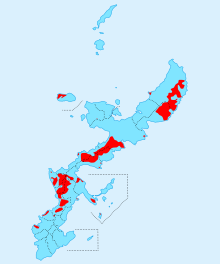
2007–present
According to a 2007 Okinawa Times poll, 85% of Okinawans opposed the presence of the U.S. military,[39] because of noise pollution from military drills, the risk of aircraft accidents,[note 5] environmental degradation,[40] and crowding from the number of personnel there,[41] although 73% of Japanese citizens appreciated the mutual security treaty with the U.S. and the presence of the USFJ.[42] In another poll conducted by The Asahi Shimbun in May 2010, 43% of the Okinawan population wanted the complete closure of the U.S. bases, 42% wanted reduction, and 11% wanted to maintain status quo.[43] Okinawan feelings about the U.S. military are complex, and some of the resentment towards the U.S. bases is directed towards the government in Tokyo, perceived as being insensitive to Okinawan needs and using Okinawa to house bases not desired elsewhere in Japan.
In early 2008, U.S. Secretary of State Condoleezza Rice apologized after a series of crimes involving American troops in Japan, including the rape of a young girl of 14 by a Marine on Okinawa. The U.S. military imposed a temporary 24-hour curfew on military personnel and their families to ease the anger of local residents.[44] Some cited statistics that the crime rate of military personnel is consistently less than that of the general Okinawan population.[45] However, some criticized the statistics as unreliable, since violence against women is under-reported.[46] Between 1972 and 2009, U.S. servicemen committed 5,634 criminal offenses, including 25 murders, 385 burglaries, 25 arsons, 127 rapes, 306 assaults and 2,827 thefts.[47] Yet, per Marine Corps Installations Pacific data, U.S. service members are convicted of far fewer crimes than local Okinawans.[48]
In 2009, a new Japanese government came to power and froze the U.S. forces relocation plan but in April 2010 indicated their interest in resolving the issue by proposing a modified plan.[49] A study done in 2010 found that the prolonged exposure to aircraft noise around the Kadena Air Base and other military bases cause health issues such as a disrupted sleep pattern, high blood pressure, weakening of the immune system in children, and a loss of hearing.[50]
In 2011, it was reported that the U.S. military—contrary to repeated denials by The Pentagon—had kept tens of thousands of barrels of Agent Orange on the island. The Japanese and American governments have angered some U.S. veterans, who believe they were poisoned by Agent Orange while serving on the island, by characterizing their statements regarding Agent Orange as "dubious", and ignoring their requests for compensation. Reports that more than a third of the barrels developed leaks have led Okinawans to ask for environmental investigations, but as of 2012[update] both Tokyo and Washington refused such action.[51] Jon Mitchell has reported concern that the U.S. used American Marines as chemical-agent guinea pigs.[52]
On September 30, 2018, Denny Tamaki was elected as the next governor of Okinawa prefecture, after a campaign focused on sharply reducing the U.S. military presence on the island.[53]
Marine Corps Air Station Futenma relocation
In 2006, some 8,000 U.S. Marines were removed from the island and relocated to Guam.[54] The move to Marine Corps Base Camp Blaz is expected to be completed in 2023. Japan paid for a majority of the cost to construct the new base.[55][56] The U.S. still maintains Air Force, Marine, Navy, and Army military installations on the islands. These bases include Kadena Air Base, Camp Foster, Marine Corps Air Station Futenma, Camp Hansen, Camp Schwab, Torii Station, Camp Kinser, and Camp Gonsalves. The area of 14 U.S. bases are 233 square kilometres (90 sq mi), occupying 18% of the main island. Okinawa hosts about two-thirds of the 50,000 American forces in Japan although the islands account for less than one percent of total lands in Japan.[38]
Suburbs have grown towards and now surround two historic major bases, Futenma and Kadena. A sizeable portion of the land used by the U.S. military is Camp Gonsalves in the north of the island.[57] On December 21, 2016, 10,000 acres of Camp Gonslaves were returned to Japan.[58] On June 25, 2018, Okinawa residents held a protest demonstration at sea against scheduled land reclamation work for the relocation of a U.S. military base within Japan's southernmost island prefecture. A protest gathered hundreds of people.[59]
Since the early 2000s, Okinawans have opposed the presence of American troops helipads in the Takae zone of the Yanbaru forest near Higashi and Kunigami.[60] This opposition grew in July 2016 after the construction of six new helipads.[61][62]
Geography
Major islands

The islands comprising the prefecture are the southern two thirds of the archipelago of the Ryūkyū Islands (琉球諸島, Ryūkyū-shotō). Okinawa's inhabited islands are typically divided into three geographical archipelagos. From northeast to southwest:
- Okinawa Islands (沖縄, ʔucinā)
- Iejima (ʔiijima)
- Kume-jima (kumijima)
- Okinawa Island (ʔuhuji)
- Kerama Islands (kirama)
- Miyako Islands (myāku)
- Yaeyama Islands ('ēma)
- Iriomote Island (ʔiriʔumuti)
- Ishigaki Island (ʔishigaci)
- Yonaguni ('yunaguni)
- Senkaku Islands (ʔiyukubajima)
- Daitō Islands (ʔuhuʔagarijima)
- Minamidaitōjima (fēʔuhuʔagarijima)
- Kitadaitōjima (nishiʔuhuʔagarijima)
- Okidaitōjima (ʔuciʔuhuʔagarijima)
Natural parks
Approximately 36% percent of the total land area of the prefecture was designated as natural parks, namely the Iriomote-Ishigaki, Kerama Shotō, and Yambaru National Parks; Okinawa Kaigan and Okinawa Senseki Quasi-National Parks; and Irabu, Kumejima, Tarama, and Tonaki Prefectural Natural Parks.[63]
Ecology
The dugong is an endangered marine mammal related to the manatee.[64] Iriomote is home to one of the world's rarest and most endangered cat species, the Iriomote cat. The region is also home to at least one endemic pit viper, Trimeresurus elegans. The islands of Okinawa are surrounded by some of the most abundant coral reefs found in the world.[65][66] The world's largest colony of rare blue coral is found off Ishigaki Island.[67] The sea turtles return yearly to the southern islands of Okinawa to lay their eggs. The summer months carry warnings to swimmers regarding venomous jellyfish and other dangerous sea creatures.
Okinawa is a major producer of sugar cane, pineapple, papaya, and other tropical fruit, and the Southeast Botanical Gardens represent tropical plant species.


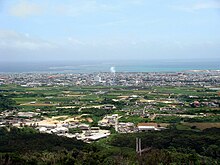
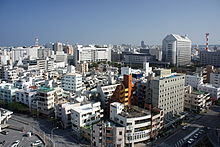
Geology
The island is largely composed of coral, and rainwater filtering through that coral has given the island many caves, which played an important role in the Battle of Okinawa. Gyokusendo[68] is an extensive limestone cave in the southern part of Okinawa's main island.
Climate
The island experiences temperatures above 20 °C (68 °F) for most of the year. The climate of the islands ranges from humid subtropical climate (Köppen climate classification Cfa) in the north, such as Okinawa Island, to tropical rainforest climate (Köppen climate classification Af) in the south such as Iriomote Island. Snowfall is unheard of at sea level. However, on January 24, 2016, sleet was reported in Nago for the first time on record.[69]
Municipalities
Cities
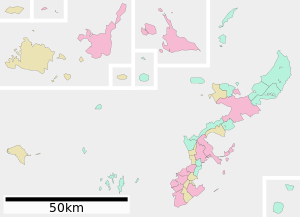
City Town Village
Eleven cities are located within the Okinawa Prefecture:
| Name | Area (km2) | Population | Map | ||||
|---|---|---|---|---|---|---|---|
| Rōmaji | Kanji | Okinawan[70] | other languages
(name in brackets) | ||||
| Kana | Rōmaji | ||||||
| 宜野湾市 | じのーん | Jinōn | 19.51 | 94,405 | |||
| 石垣市 | いしがち | ʔIshigaci | Isïgaksï, Ishanagzï (Yaeyama) | 229 | 47,562 | ||
| 糸満市 | いちゅまん | ʔIcuman | 46.63 | 59,605 | |||
| 宮古島市 | なーく、みゃーく | Nāku, Myāku | Myaaku (Miyakoan) | 204.54 | 54,908 | ||
| 名護市 | なぐ | Nagu | Naguu (Kunigami) | 210.37 | 61,659 | ||
| 那覇市 | な |
Nafa | 39.98 | 317,405 | |||
| 南城市 | Fēgusiku | 49.69 | 41,305 | ||||
| 沖縄市 | うちなー | ʔUcinā | 49 | 138,431 | |||
| 豊見城市 | Timigusiku | 19.6 | 61,613 | ||||
| 浦添市 | うら |
ʔUrasī | 19.09 | 113,992 | |||
| うるま市 | うるま | ʔUruma | 86 | 118,330 | |||
Towns and villages
These are the towns and villages in each district:


